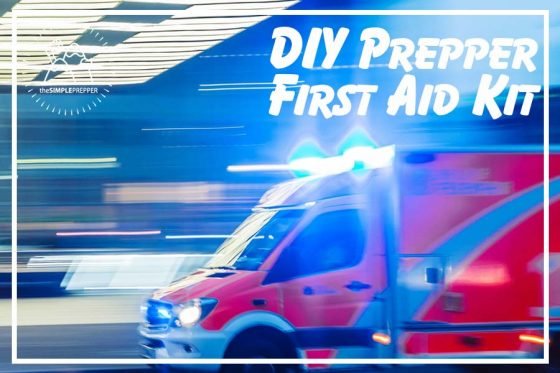This article was originally published by Prepper Aaron at The Simple Prepper.

Whether it’s a car crash, a natural disaster, or a small accident at home, if there’s an emergency, you need to make sure you have the equipment you need to act quickly. The best way to be ready is to have a dedicated prepper first aid kit that lives at home or in your car so that you can grab it at a moment’s notice.
You could easily buy a pre-made first aid kit, however many preppers feel more comfortable knowing exactly what goes into their kit so they’re more prepared to use it properly. Plus, if you build your own kit, you’ll be able to customize it to your needs.
It’s easy to get overwhelmed by the sheer number of items that you might need in an emergency. To help you out, we’ve created this survival first aid kit list so you know what to buy. We’ve added little notes and information about each item so you’ll be more knowledgeable about what you have and how to use it.
The Prepper First Aid Kit
Any good prepper first aid kit will have a fairly extensive selection of items to treat everything from a rolled ankle to diabetic shock. While this list is quite long, we’ve only chosen items that one really shouldn’t do without. Of course, if you’re looking to have your kit with you at all times, it might not be feasible to have something that’s very large or bulky. On the other hand, if you have a first aid kit stashed in your car or in a great place in your house, you can afford a large and very thorough kit.
So, what does go into a prepper first aid kit? Here’s a list of important survival gear that you should have in your kit, organized by use. You’ll notice that we’ve included a recommended number for each item. If you have a smaller kit, you’ll want to adjust accordingly. To be prepared, this is what you’ll need:
The First Aid Kit Bag
 Regardless of how many items you have, you’ll need some way to store them all. So, you’ll need a dedicated first aid bag that’s easy to grab in an emergency. There are hundreds of bags on the market with an array of different designs, features, pockets, and straps. You’ll want to choose one that’s affordable, durable, and easy to use. At the end of the day, a solid waterproof dry sack will work, but having something a bit more organized can be helpful for finding things quickly.
Regardless of how many items you have, you’ll need some way to store them all. So, you’ll need a dedicated first aid bag that’s easy to grab in an emergency. There are hundreds of bags on the market with an array of different designs, features, pockets, and straps. You’ll want to choose one that’s affordable, durable, and easy to use. At the end of the day, a solid waterproof dry sack will work, but having something a bit more organized can be helpful for finding things quickly.
Rothco EMT/EMS/First Responder Medical Bag, Red
8 Essential Medical Tools
These are bits of your first aid kit that you really shouldn’t do without. They’re either use in a number of situations or can be absolute lifesavers. It’s best to have a dedicated set of each of these things in your first aid bag so you’re ready to go.
Trauma Shears (1)
If someone is unconscious and you need to remove their clothing, a normal pair of scissors won’t do. A pair of good trauma shears can cut through nearly anything without hurting someone.
Thermometer (1)
Useful for checking on fevers and someone’s general state of well-being. If you have kids, consider an infrared forehead thermometer, but a small sublingual (under the tongue) or ear thermometer will do. Remember: you might need spare batteries.
Medical Tweezers (1)
You’ll want a pair of dedicated medical tweezers that can remove anything from a splinter to a tick if need be.
Toenail Clippers (1)
Useful for preventing ingrown toenails and maintaining personal hygiene.
Nitrile (non-Latex) Gloves (3-6)
These are an absolute must. If you want to prevent transmission of infectious diseases and protect yourself when you’re helping others, get yourself some nitrile gloves. Don’t get latex (many people are seriously allergic) and you’ll need at least 3 pairs, just in case some get dirty. Oh – and don’t forget a plastic bag or biohazard bag to put them in when you’re done.
Irrigation Syringe (1)
Very important for keeping wounds clean and preventing infections. These have enough pressure to actually scrub it clean and flush out a deep cut without an irrigation syringe.
Q-tips (50 pack)
Useful for spreading ointments and creams on a wound or small area.
CPR Pocket Mask (1)
If you’re not CPR trained, you should be. You’ll want a good CPR pocket mask to perform rescue breaths with, should the situation arise. Mouth-to-mouth really isn’t recommended in most situations, for personal hygiene reasons. We highly recommend a pocket mask with a one-way valve. People tend to vomit when CPR is performed on them and without a one-way valve… well, you get the picture.
13 Essential OTC Medicines
You can improvise a lot of a medical kit, but you just can’t make medicine appear out of thin air. These prepper medicines are incredibly important for treating a variety of conditions and can save someone’s life.
Aspirin (20-50 pills)
Incredibly important for treating people in cardiac arrest. Be sure to go for the baby/chewable aspirin variety. If you get the adult kind, it comes in coated tablets, which aren’t digested quickly enough to help someone in cardiac arrest.
Antihistamines (Benadryl) (20-50 pills)
When we think of someone in anaphylaxis, we often think an Epi-Pen will save them. Actually, the Epi-Pen just buys enough time for the antihistamines to start working. These literally save lives, so don’t forget them.
Ibuprofen (Advil) (20-50 pills)
A great over-the-counter drug that’s great a great anti-inflammatory.
Acetaminophen (Tylenol) (20 -50 pills)
Similar to Ibuprofen, but with a different mechanism of action. Great as a fever reducer, too.
Loperamide (20-50 pills)
If you’ve ever traveled somewhere with poor water sanitation systems, you’ll understand the horrors of excessive diarrhea. Besides being horrible and uncomfortable, prolonged diarrhea causes serious dehydration. Loperamide can really help here, just don’t take too much, or you’ll have the opposite problem.
Claritin (20-50 pills)
Having allergies is really no fun, so a small quantity of Claritin or similar can really brighten someone’s day.
Tums (100 pack)
Mild stomach upsets often just need a little love and care. Tums are great for helping people feel just that little bit better when their digestive system isn’t cooperating.
Dramamine (20-50 pills)
Anyone who suffers from motion or seasickness will praise Dramamine to the ends of the Earth. Seasickness can actually be fatal if it causes you to vomit continuously for an extended period of time. A great drug that works amazingly, if taken before the motion starts.
Sudafed (20-50 pills)
Great for making someone with a cold feel a whole lot better. It’s worth having adult and kid’s varieties of this.
Throat Lozenges (50 doses)
Always good for a sore throat. Ricola, Halls, or any of your favorite lozenges will do.
Laxatives/Stool Softeners (20-50 doses)
Great to have, especially if you have young children or older adults in your life. Just be mindful of how much someone takes.
Oral Rehydration Solution (3-5 packs)
If someone is suffering from vomiting or diarrhea, they’ll need to be rehydrated. While plain waterworks, it doesn’t have any of the electrolytes your body needs. You can get special oral rehydration solutions but even packets of Gatorade or Powerade mix will do.
Tube of Cake Frosting (1)
Seem silly? It is, sort of – but if someone is experiencing a diabetic emergency (particularly low blood sugar – hypoglycemia) they need sugar, and fast. You can get special glucose tubes for this reason, but a small tube of cake decorating frosting works the same, is much cheaper, and tastes way better.
A note on prescription medicines
If you or your family members take prescription medicine, it’s worth storing some in your first aid kit for an emergency. Anything you actually can’t live without is important to have in your kit. Other things, like spare inhalers, spare contact lenses/eyeglasses, and epi-pens are must-haves, too.
11 Essential Lotions, Ointments, And Creams
The items below can be key in a variety of situations, from rashes to burns. A small tube of each will probably suffice in your medical kit.
Soap (1 bar or small container)
Good ol’ soap and water is still the best way to clean most wounds.
Iodine (2-5 packets)
If you don’t have tons of water available, a small iodine solution is great for cleaning wounds.
Antibiotic ointment (1)
Be sure to thoroughly clean and irrigate a wound before using this stuff, and get a water-based product, if you can.
Hydrocortisone (1)
Great for rashes, itching, eczema, and a number of other conditions. Definitely worth having if you have kids, too.
Anti-fungal cream (1)
Treats athlete’s foot or other foot fungi.
Alcohol Prep Pads (10-30)
This is great for cleaning skin before insulin prick-tests or for sterilizing medical equipment.
After-Bite Cream (1)
For bug bites or stinging nettle pricks as they often have a small amount of lidocaine in them. Very important if you have kids.
Burn Cream (1)
Great for soothing minor burns after they’ve been cleaned.
Sunscreen (Zinc Oxide) (1)
Sunburns are horrible, so be sure to lather up. A small tube of Zinc Oxide will go a long way. Just because it’s an emergency doesn’t mean you have to expose yourself to damaging UV rays.
Aloe Vera (1)
Just in case you forgot your sunscreen. Great for those bad sunburns and very mild burns without broken skin. Try and get a non-dyed variety. These will be clear instead of neon green.
Bug Spray (1)
Mosquitos can cause all sorts of horrible diseases, so protect yourself with some bug spray.
3 Important Trauma Supplies
Whether it’s a car crash or a simple cut, if someone’s bleeding, you want to stop it fast. These are great prepper medical supplies for use in any trauma situation.
Sterile Gauze Pads (various sizes) (20-50)
There are many sizes of gauze pads from little 1”x1” to abdomen-sized behemoths. You’ll want to stock your kit with an assortment of all sizes, but particularly the 2”x2” and 4”x4” variety.
Band-aids (various sizes) (50-100)
It’s good to have a selection of sizes and types. Having some of the fun Disney character band-aids are also a great way to cheer up the little ones.
Quick-clot (3-5)
This stuff is really a lifesaver. It uses clotting mechanisms to quickly stop major bleeds.
7 Essential Sports Injury Supplies
Cloth medical tape (1-3)
A good roll of cloth medical tape can be used to tape an injured wrist or ankle. You can also use it to wrap up a gauze bandage in a trauma situation.
Sam Splint (1)
These little aluminum-lined foam boards are worth their weight in gold. You can use them to mold your own splints for broken arms or even to make a cervical spine collar. An unlimited number of uses if you get creative.
Triangle Bandages (3-5)
These are amazing for creating slings and swaths for broken arms, collarbones, and shoulder dislocations. They’re small and weigh nothing, so get a few.
Ace Wrap (3-5)
Most people who have had a sprained ankle understand the value of the ace wrap. Be sure to get a few, though, as they don’t work terribly well when they get all sweaty or stretched out.
Moleskin (3-5 sheets or 1 roll)
Protects a hotspot before it becomes a blister.
Molefoam (3-5 sheets)
Protects fluid-filled blisters with a layer of foam so they don’t rub more or pop.
Second Skin (2-3 packages)
Great if a blister pops or for some moderate burns.
5 Items If You Have Medical Training
These are quite advanced tools that really should only be used by people with advanced medical training. It’s worth taking a first aid class, if you haven’t already, and they might cover the use of some of this equipment.
Suture kit (1)
Perfect for gaping wounds that need to be closed.
Scalpel (1)
A surgical scalpel has a vast number of uses in the right hands.
Stethoscope (1)
Great for listening to lung and heart sounds, but without training, you won’t know what to look for.
Tourniquet (1-2)
While it may seem like a simple device, it can cause irreversible limb damage and, ultimately, amputation. Use with care and know the proper protocols before you do.
Slishman Traction Splint (1)
Amazing for femur fractures, but requires some special knowledge. Actually quite compact, but would only fit in a large first-aid kit.
10 Other Important Odds And Ends
These are must-haves that people often forget. You’ll certainly want them in an emergency, though.
Pocket-sized First Aid Book (1)
Even if you’re well-trained, it’s easy to forget what you know in the heat of the moment. A small first-aid book can remind you how to care for particular injuries or illnesses.
Pen and/or Pencil (1-2)
If you are treating someone over the long-term, you’ll want to record vital signs and other notes about their condition. You can’t really do that without a writing implement, so a pen or pencil is important.
All-weather Notebook (1)
Used to keep notes about a patient’s condition and to ultimately give to medical professionals who are taking over their care. An all-weather notebook won’t let you down in the rain.
Tick remover (1)
Lyme disease is horrible, so removing ticks promptly is important. You can use tweezers, but these special tick removers do the job perfectly with minimal fuss.
Menstrual Hygiene Products (10-20)
Even if you don’t menstruate, having some spare products can really make someone’s day so much better. Plus, they’re super absorbent and can be great gauze substitutes if you run out.
Duct Tape (1 roll)
It’s duct tape. Enough said.
Accessory Cord/Paracord (20ft)
A small amount of accessory cord can be used for nearly everything. It can be used to make a splint or pitch a tarp for shelter.
Knife (1)
Knives have so many uses, so you might as well have a small one in your kit.
Lighter/Waterproof Matches/Firestarter (1 pack)
If you get stranded somewhere, you might need to start a fire. Waterproof matches are awesome, but any fire starting tool will do.
Ziploc bags/Biohazard Bags (5-10)
Very important for containing used nitrile gloves and gauze. Have a few dedicated to this purpose.
To Sum Up
Whew! That was a lot to get through, but we’re glad you stuck with us. Having a well-stocked first-aid kit that’s ready to go at a moment’s notice is one of the most proactive things you can do to be prepared.
In addition to having a great medical kit, it’s worth investing in some formal first aid training. Wilderness medical classes or specialized disaster training schools offer some essential information and give you the chance to get some hands-on practice.
Now that you have a great first aid kit, you can feel more prepared for whatever may come.
This article contains affiliate links.










0 Comments